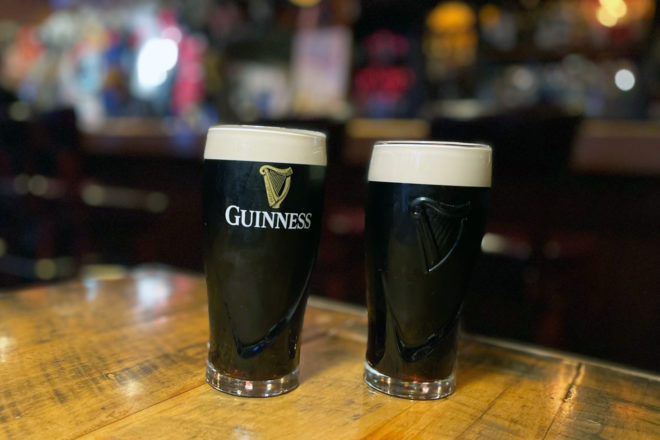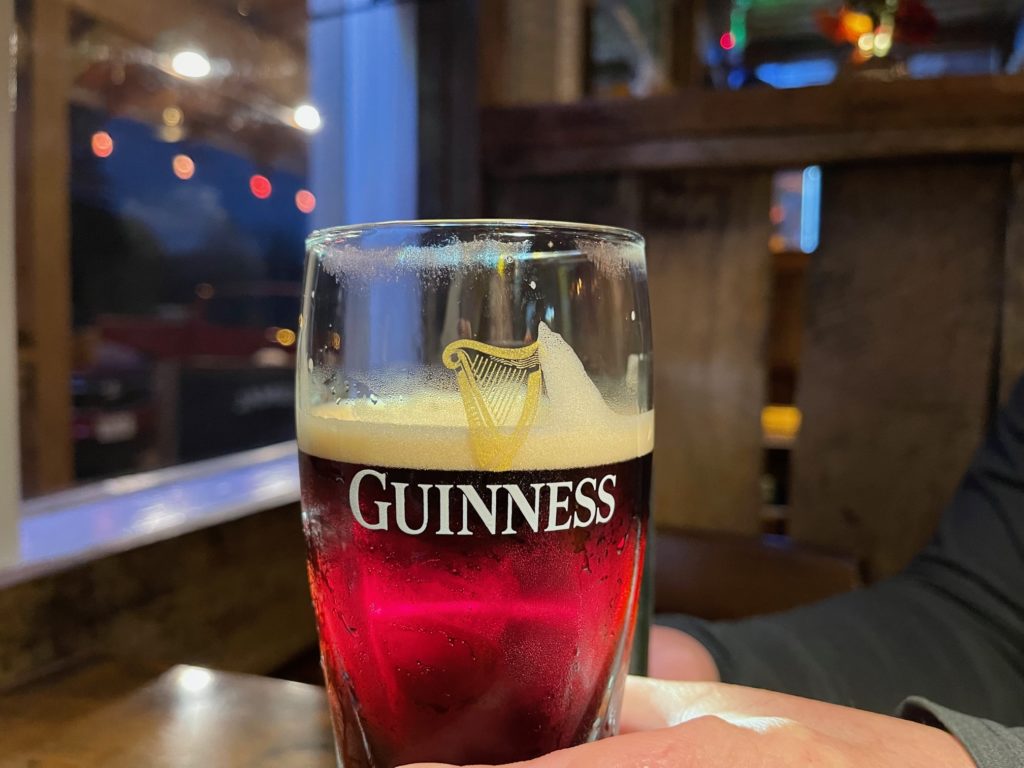Happy Hour with Kait: Going All Irish
- Share
- Tweet
- Pin
- Share

It was mid-November, and one of the first season’s-over stops was at a year-round place: Coyote Roadhouse in Baileys Harbor. Crazy crowded in season, I glide right into a front-of-place parking space. It’s like exhaling without realizing I’d been holding my breath.
We slide into a booth, no reservations required. Low ceilings, a forest of wood, soft light, muffled conversation from stool patrons and other booths, everything close and cozy. Unseasonably warm, too. One fruit fly, giddy with flight, wasn’t going to leave us alone. Kait clapped her hands in the air, missed the fly, and ordered a shot of Irish whiskey, Tullamore Dew, to get us started.
“We’re going all Irish tonight,” she said.
Kait is a coworker and beer connoisseur. She was going to teach a Fitz like me a thing or two about drinking Guinness. The occasion for the beer selection was her impending departure with hubby for southern Ireland, east to west. I had a pen pal in sixth grade, Siobhan Sweeney, who lived in Belfast, Northern Ireland.
“We’ve never been to Northern Ireland,” Kait said. “We can’t take our rental car there because it’s a different country. Six counties are still owned by the UK, and the rest is the Republic of Ireland.”

A little more history, and our Guinness arrived, my memory fastening on two words for the dark stuff: “bloat” and “blech.”
“An actual, proper pint of Guinness is a 20-ounce pour,” Kait said, assessing the 16-ounce pints, but still – a “proper pour.”
She explained how to achieve a stout’s signature, two-part pour. Marketing ploy or necessity, no matter.
“You should hold the glass at a 45-degree angle, and pour on the harp,” she said.
The harp – that’s not just a decoration on the outside of the glass? She gave me the Kait look: chin dipped, eyebrows raised.
“It’s not just there for decoration,” she said. “It’s there to guide you, and then you finish your pour.”
What if there’s no harp on the glass?
Clap! Missed the fruit fly.
“If you don’t have a harp on the glass, it’s not a proper pint,” Kait said. “Stop at the top of the harp, and finish the second pour.”
She assessed the foam on the pours, called it “about right.” The thick, tight, long-lasting foam; the creaminess; the mouth feel – they all come from the Guinness nitrogen/CO2 blend of gas that pushes the beer through the lines. Other drafts are only CO2 fed.
I always thought it was the beer, not what’s delivering the beer.
“Any beer you poured on nitro would have this same characteristic,” Kait said.
That’s not to say that any beer poured on nitro would be Guinness. Guinness has a pedigree, class – history. Arthur Guinness signed a 9,000-year lease in 1759 for 45 pounds per year and started the St. James Gate Brewery in Dublin. The rest is history.
“He was 34 years old,” Kait said, swatting the fly away from the beer, then clapping again and opening her hands. Nothing. Were there other dark beers when Guinness began brewing Guinness?
“There were other dark beers,” she said. “Probably some crappy English porters. Wait – don’t write that.”
Too late. She smiles her wicked Kait smile, gives a highly summarized history. First there were English ales. Then someone said, “Hey, let’s brew with malted barley” (barley that’s soaked in water and allowed to germinate), and porters were born. Then someone said, “Hey, let’s brew with unmalted barley and roast it.” Hello, stouts.
But backing up – Guinness is not a dark beer, Kait corrected.
“It’s a deep, ruby red,” she said.
Maybe she can lead me to discover the complexities of taste in a beer, but I know a dark beer when I see it, and this was absolutely umber. She shines her phone flashlight behind the glass, and voilà: deep, ruby red.
We drink, talk about some things that really shouldn’t be written. I love dark chocolate – the higher the cocoa content, the better. This Guinness had that slightly bitter taste with a chocolate edge. Memory hadn’t served me well: This was good, not blechy at all. And it tasted lighter, like a flourless brownie.
“It’s probably the creamy mouthful,” she said. “Twelve ounces is only 125 calories. That’s not a lot. If you buy a light beer, it’s 95-110 calories.”
She reached out with a wide, swathing swipe to try to corral the relentless fruit fly.
“You should taste the bitterness,” she continued. “You should taste the roasted barley. I mean, there’s only three ingredients: water, hops and barley. What I like is, it doesn’t leave a nasty taste in your mouth. Some IPAs can leave a bitter taste. You’re getting that from the hops in an IPA.”
Kait drinks Guinness before trips to Ireland and more in the winter, but you can’t get Guinness on draft just anywhere in Door County. She thinks out loud: Coyote, Husby’s, Kitty O’Reilly’s, the Cornerstone. She likes the lightness of a Guinness – the lower, 4.2% alcohol content.

“I can drink two or three Guinnesses, and know I’ve consumed less calories and less alcohol,” she said.
She swats the air, her hand closing as quick as a Venus flytrap.
“On the flip side, I really like 9% IPAs, too,” she said.
She opened her palm. Nailed the fruit fly.
“There are hundreds of stouts. Guinness, you could probably call the original stout. If your opinion differs from mine – get over it,” said Kait.
Kait is the brewery coordinator for the Door County Beer Festival.



